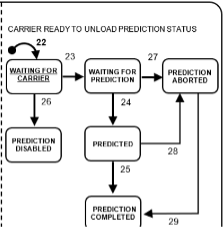Background
The SEMI North America, the Information & Control Committee meets three times per year; spring summer and fall. This year the fall meetings were held on November 6, 7 and 8, 2023 at SEMI headquarters in Milpitas, CA. The meetings include task forces with leaders from Cimetrix on the GEM 300, ABFI (Advanced Backend Factory Integration), GUI, DDA, CDS task forces as well as the committee meeting on the final day which was held on Thursday instead of the typical Wednesday. This is a summary of what happened in the task forces I am highly involved in including GEM 300, ABFI and DDA. The recent voting cycle included 22 ballots—the most ballots in one voting cycle that we have seen for a very long time.
Note that all ballots that pass in the committee are still subject to a final review by the global SEMI Audit & Review committee, where a ballot can still fail when proper SEMI procedures and regulations are not strictly followed.
GEM 300 Task Force
A lot is going on the GEM 300 task force. The following SEMI standards were reapproved: E39 and E39.1. Reapprovals occur every 5 years else a standard becomes inactive.
Ballot 7066A proposed changes to the SEMI E87 Carrier Management Services (CMS) standard. This ballot failed previous voting, but now time passed as a ‘superclean’ ballot (no negatives or comments during voting). This ballot included a significant change to the Carrier Ready to Unload Prediction feature which is now called a Carrier Complete Prediction. Anyone who implemented Carrier Ready to Unload Prediction will have to make a lot of changes to comply with the new implementation. A primary driver for this change is to accommodate internal buffer equipment where the READY TO UNLOAD state depends on when the host sends a CarrierOut message and the queue of previously requested activities; therefore, not a useful prediction to make.

The benefit of this new state model is to notify the factory host before a carrier is completed so that the automatic delivery can be scheduled to arrive for pickup when the carrier is ready. This can shorten the time it takes for the factory to move material from one equipment to the next.
Seven similar ballots 7114, 7115, 7116, 7117, 7118, 7119 and 7120 were submitted respectively for standards E5/E30, E40, E87, E90, E94, E116 and E157 to define a ‘well-known name’ for each require collection events, variables and alarms. The ‘well-known’ names are aliases for mapping purposes; necessary because each implementation can use different names. The ultimate goal of this feature is to make the GEM and standards based on GEM more plug-and-play. This new feature serves at least two purposes. Standard E172 already defines a well-known name attribute in the SECS Equipment Data Dictionary (SEDD) file. In the Equipment Data Acquisition (EDA) standard freeze 3 version, E164 will use this well-known name as well. The regular GEM documentation can also reference the well-known name. To explain the value of this feature, E90 requires a collection event for Substrate Location State Model transition 1. Implementers might define this collection event using any name such as E90_Loc_Unoccupied2Occupied, SLTrans1, SubstrateLocationUnoccupiedToOccupied or CollectionEvent901. Any name is allowed. The new well-known name establishes a standardized alias name called the well-known.
![]()
When ballot 7117 is published, the well-known name table establishes well-known name “E90:SubstrateLocation:001:Unoccupied-Occupied” as the standardized alias for this collection event. This SEDD file can be downloaded through the GEM interface, tell the GEM host exactly which collection event implements the Substrate Location State Model transition 1. During the Information & Control Committee, ballot 7117 resulted in a Ratification ballot handling a long existing E90 naming issue for one status variable. All of the other ballots passed with a simple editorial change.
A few of the above well-known name ballots included additional line items to resolve issues in the respective standard, mostly editorial or minor. Ballot 7114 included an E5 clarification that Stream 21 Function 17/18 sequence can be aborted by the receiving entity with an S21F0 message. Ballot 7116 included several additional changes/corrections to E87.
1. Clarification on the CARRIER SLOT MAP STATUS state SLOT MAP VERIFICATION FAILED, which sometimes was spelled in E87 without the ‘ED’ in FAILED.
2. Corrections to Table R1-21 in the table heading.

3. Carrier object attribute Capacity can now be format code 51, 52 or 54, increasing the allowed carrier size from 255 to 4.29 GB to accommodate carriers not holding wafers but smaller substrates.
4. Carrer state model transition 7 includes a new trigger as already described scenario R1-21.
5. Scenario R1-20 was reverted to its original design, undoing an error introduced in 2012
6. And finally, equipment constant BypassReadID was added to E87.1. This equipment constant has been defined in E87 but missing in E87.1
Ballot 9836 proposed some synchronized changes in E87 and E90 to define new name/value pair attributes. The ballot failed due to some limiting details in the value format definition. The ballot intends to allow equipment and factory to agree to using additional substrate content and characteristic information.
The Japan GEM 300 task force is working on improving the GEM E30 standard. The task force proposed a number of minor improvements mostly editorial to clean up several areas with the specification. Although the work was originally proposed to occur in the North America group, the task force decided to handle this ballot in Japan who will meet in December of 2023. Of course, the regional GEM 300 task forces worldwide all share and vote together on all E30 ballots.
DDA (Diagnostics Data Acquisition) Task Force
The DDA task force reapproved three standards: E128, E138 and 145. Additionally, the DDA task force made more plans to complete the Equipment Data Acquisition (EDA) freeze 3 version. Here are the key activities and findings as of today:
- E164 will be modified to incorporate the well-known names from the GEM 300 force. Instead of including all GEM 300 standards directly in the E164 primary standard, each GEM 300 standard will have a smaller, simpler E164 subordinate standards (E164.1, E164.2, …) to define the EDA implementation for that standard. This strategy makes adopting EDA and E164 more flexible to use in industries beyond semiconductor front end equipment.
- Some errors were found in the published .proto files for E132 and E134. New ballots will be submitted as soon as possible to make corrections.
- A software vendor test #2 will be held immediately following the North America Information & Control Spring meetings. Anyone implementing client and/or server software is invited to attend. Instead of testing for standard compliance, the purpose of the vender test is to test interoperability and flush out any remaining issues in the EDA freeze 3 standards. This software vender test session #2 will focus on previously untested E132 features from software vender test session #1 and will also include E125 tests. Anyone interested in joining should contact me (Brian Rubow) or Albert Fuchigami (Brian’s co-leader). Prior to the software vender test session, the task force co-leaders will provide a test plan document and .proto files with corrections in E132 for known issues.
- A software vender test session #3 will be held immediately following the North America Information & Control Summer meetings held in conjunction with SEMICON West. This test session will focus on E134 testing.
ABFI (Advanced Backend Factory Integration) Task Force
Ratification ballots R2924A and R6925A both passed. This means that the new Consumables and Durables standard is in the SEMI publication queue.
Additionally, ballot 6948 passed with several great improvements to the E142 substrate mapping standard. The improvements should help users better understand how to use the E142 schema files for more consistent adoption by implementers.
Spring 2024
The next North America Information and Control spring meetings will be held again at SEMI headquarters in Milpitas, California. The dates will be March 25-27, 2024. Although many attendees were remote during these meetings, I expect many more attendees to be in person at these spring meetings due to the EDA software vender test session.
To learn more about the SEMI Standards and the work we do as members of SEMI, please click the button below.





